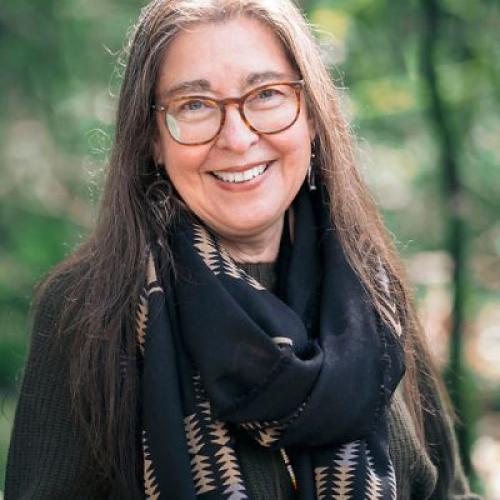
Eisenberg, Cristina
- Traditional Ecological Knowledge
- Fire Ecology
- Ethnobotany
- Soil Ecology
- Wildlife Ecology
- Restoration Ecology and Ecocultural Restoration
- Environmental Philosophy and Ethics
Current Research Projects and Partnerships: BLM Pacific Northwest Tribal Conservation Corps Seeds of Success Forest Ecocultural Restoration Project; BLM Fort Belknap Indian Community Grassland Restoration Project; USDA Forest Service Old-Growth Forest Tribal Roundtables
-
FES 599 STTraditional Ecological Knowledge and Best Practices for Partnering with Tribal Nations
Gao, S., Eisenberg, C., Morford, S.L. and DeLuca, T.H. 2024. Fire exclusion, pyrogenic carbon, and ecosystem function: What have we lost?. Anthropocene 46: 100438.
Eisenberg, C., Prichard, S., Hessburg, P., Nelson, M.P., Asselin, H., . . . & Zampieri, N. 2024. Braiding Indigenous and Western Knowledge for Climate-Adapted Forests: An Ecocultural State of Science Report. https://depts.washington.edu/flame/mature_forests/pdfs/BraidingSweetgra…;
Eisenberg, C., and Nelson, M.P., 2023. Two-Eyed Seeing: Animal Dignity through Indigenous and Western Lenses. Animal Dignity: Philosophical Reflections on Non-Human Existence, p.155.
Eisenberg, C. 2020. “Afterword: Cultural Keystone Species and Traditional Ecological Knowledge on the Northern Plains and Beyond,” In Grace Morgan, Beaver, Bison, Horse: An Indigenous Ecology of the Prairies (Regina, Sask: University of Regina Press).
Aronson, J., Goodwin, N., Orlando, L., Eisenberg, C., & Cross, A. T. 2020. A World of Possibilities: Six Restoration Strategies to support the United Nation's Decade on Ecosystem Restoration. Restoration Ecology 28 (4):730-736.
Gann, G., T. McDonald, B. Walder, J. Aronson, C. R. Nelson, J. Jonson, C. Eisenberg, J. G. Hallet, M. R. Guariguata, J. Liu, F. Hua, C. Echeverria, and K. W. Dixon. 2019. International Principles and Standards for the Practice of Ecological Restoration. Restoration Ecology (S1):S1-S46.
Eisenberg, C., C. L. Anderson, A. Collingwood, R. Sissons, C. J. Dunn, G. W. Meigs, D. E. Hibbs. S. Murphy, S. Dakin Kuiper, J. SpearkChief-Morris, L. Little Bear, B. Johnston, and C. B. Edson. 2019 Out of the Ashes: Ecological Resilience to Extreme Wildfire, Prescribed Burns, and Indigenous Burning in Ecosystems. Frontiers in Ecology and Evolution (7):436.
Eisenberg, C. 2018. “Conserving Biological Diversity,” in pp. 387-404 J. F. Franklin, K. N. Johnson, and D. Johnson, eds., Ecological Forest Management. Chicago: Waveland Press.
McDonald, T., J. Aronson, G. Gann, and C. Eisenberg. 2018. The SER Standards, cultural ecosystems, and the nature-culture nexus – a reply to Evans & Davis. Restoration Ecology 27(2):243-246.
Kirkland, M., C. Eisenberg, Bicerra, A., Bodmer, R. E., Mayor, P., and Axmacher J. C. 2018. Sustainable wildlife extraction by the Kukama-Kukamilla people of the Pacaya-Samiria National Reserve, Peru. Oryx: 1-10.
Eisenberg, C. 2018. Foreword. In pp. vii-xii, Paul. A. Colinvaux, Why Big Fierce Animals are Rare: An Ecologist’s Perspective (Princeton, NJ: Princeton University Press).
Chandler, M., S. Rullman, J. Cousins, N. Esmail, E. Begin, G. Venicx, C. Eisenberg, and M. Studer. 2017. Ecological and social outcomes from 7 years of citizen science evaluation: Use of a novel evaluation tool on Earthwatch-supported projects. Biological Conservation 208:163-173.
Eisenberg, C. 2017. The science of open spaces: theory and practice for conserving large complex systems. Ecological Restoration 35(3): 276-277.
Boukili, V. K. S., D. P. Bebber, T. Mortimer, G. Venicx, D. Lefcourt, M. Chandler, and C. Eisenberg. 2017 Assessing the performance of urban forest carbon sequestration models using direct measurements of tree growth. Urban Forestry and Urban Greening 24(3):212-221.
Eisenberg, C., D. E. Hibbs, and W. J. Ripple. 2015. Effects of predation risk on elk landscape use in a wolf-dominated system. Canadian Journal of Zoology 93:99-111.
Beschta, R. L., C. Eisenberg, J. Laundre, W. J. Ripple, and T. J. Rooney. 2014. Predation risk, elk, and aspen: tests of a behaviorally mediated trophic cascade in the Greater Yellowstone Ecosystem: Comment. Ecology 95(5):2669-2679.
Eisenberg, C., D. E. Hibbs, W. J. Ripple, and H. Salwasser. 2014. Context dependence of elk vigilance and wolf predation risk. Canadian Journal of Zoology 92:727-736.
Eisenberg, C., The Carnivore Way, Coexisting with and Conserving America’s Predators. Washington, DC: Island Press, 2014.
Eisenberg, C., "Quantifying Wildness." in P. Hasbach, and P. Hahn, Eds., Rediscovery of the Wild. Massachusetts: Massachusetts Institute of Technology Press, 2013.
Seager, S. T., C. Eisenberg, and S. B. St. Clair. 2013. Patterns and consequences of ungulate herbivory on aspen in western North America. Forest Ecology and Management 299:81-90.
Rogers, P., C. Eisenberg, and S. B. St. Clair. 2013. Resilience in quaking aspen: Recent advances and future needs. Forest Ecology and Management 299:1-5.
Eisenberg, C., "Lessons from 763," in T. Fleischner, ed., The Way of Natural History. San Antonio: Trinity University Press, 2011.
Eisenberg, C., The Wolf’s Tooth: Keystone Predators, Trophic Cascades, and Biodiversity. April 2010. Washington, DC: Island Press, 248 p. more info